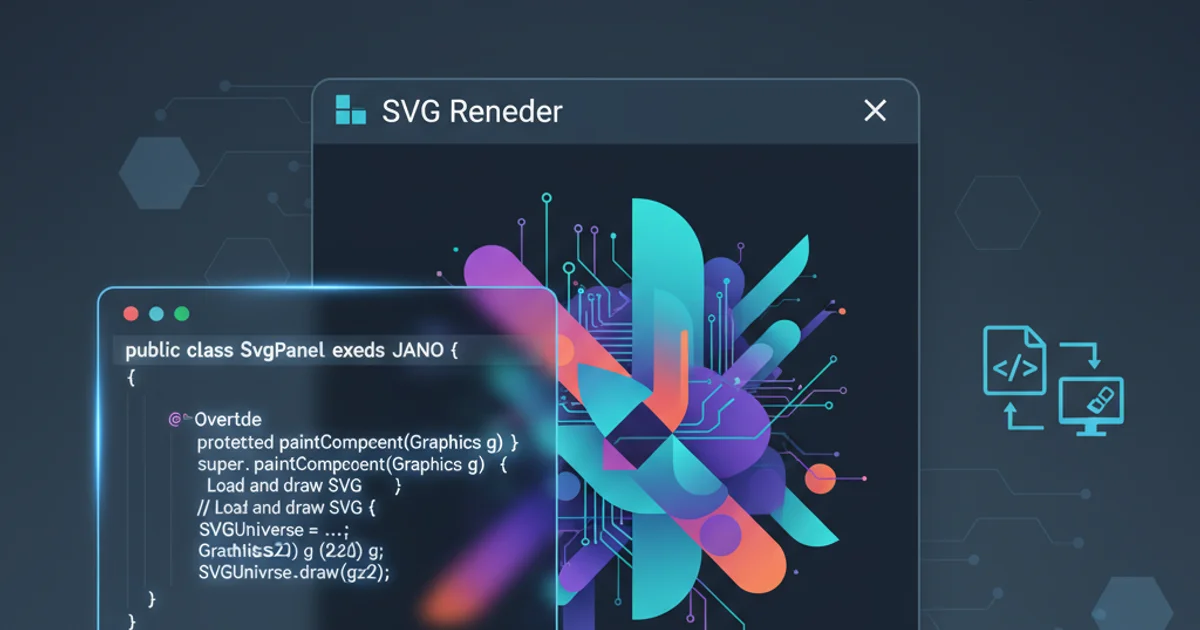Draw SVG images on a JPanel
Categories:
Rendering SVG Images on a JPanel in Java Swing

Learn how to effectively display Scalable Vector Graphics (SVG) images within your Java Swing applications using various libraries and techniques.
Integrating Scalable Vector Graphics (SVG) into Java Swing applications can be a powerful way to enhance your UI with high-quality, resolution-independent graphics. Unlike raster images (like PNG or JPEG), SVGs scale perfectly to any size without pixelation, making them ideal for icons, diagrams, and complex illustrations. This article explores different approaches to drawing SVG images on a JPanel, focusing on popular libraries that simplify the process.
Understanding SVG and Java2D
SVG is an XML-based vector image format for two-dimensional graphics with support for interactivity and animation. Java's java.awt.Graphics2D API provides a rich set of primitives for drawing shapes, text, and images, but it doesn't natively support SVG parsing and rendering. To bridge this gap, we rely on third-party libraries that can interpret SVG XML and translate it into Graphics2D drawing commands. These libraries typically parse the SVG file, create a corresponding object model, and then provide a method to 'paint' this model onto a Graphics2D context.
flowchart TD
A[SVG File] --> B{SVG Parsing Library}
B --> C[SVG Document Object Model]
C --> D{Graphics2D Renderer}
D --> E[JPanel's paintComponent Method]
E --> F[Rendered SVG on JPanel]Workflow for rendering SVG on a JPanel
Option 1: Using Apache Batik
Apache Batik is a Java-based toolkit for applications that want to use images in the SVG format. It provides a robust SVG parser, renderer, and DOM implementation. While powerful, Batik can be quite heavy in terms of dependencies. It's suitable for complex SVG rendering needs, including animation and interactivity.
import org.apache.batik.swing.JSVGCanvas;
import javax.swing.*;
import java.awt.*;
import java.net.URL;
public class BatikSvgPanel extends JPanel {
private JSVGCanvas svgCanvas;
public BatikSvgPanel(URL svgUrl) {
setLayout(new BorderLayout());
svgCanvas = new JSVGCanvas();
svgCanvas.setURI(svgUrl.toString());
add(svgCanvas, BorderLayout.CENTER);
}
public static void main(String[] args) {
SwingUtilities.invokeLater(() -> {
JFrame frame = new JFrame("Batik SVG Example");
frame.setDefaultCloseOperation(JFrame.EXIT_ON_CLOSE);
frame.setSize(400, 400);
URL svgUrl = BatikSvgPanel.class.getResource("/path/to/your/image.svg"); // Replace with your SVG path
if (svgUrl != null) {
frame.add(new BatikSvgPanel(svgUrl));
} else {
frame.add(new JLabel("SVG file not found!"));
}
frame.setVisible(true);
});
}
}
Example of rendering SVG using Apache Batik's JSVGCanvas.
batik-swing, batik-dom, batik-codec, batik-util, batik-xml) in your project's classpath. Maven users can add the appropriate dependencies.Option 2: Using SVG Salamander (svgSalamander)
SVG Salamander is a lightweight and easy-to-use library for rendering SVG images in Java. It's often preferred over Batik for simpler use cases due to its smaller footprint and fewer dependencies. It provides a straightforward API to load an SVG and paint it onto a Graphics2D context.
import com.kitfox.svg.SVGDiagram;
import com.kitfox.svg.SVGUniverse;
import javax.swing.*;
import java.awt.*;
import java.io.IOException;
import java.net.URI;
import java.net.URL;
public class SalamanderSvgPanel extends JPanel {
private SVGDiagram diagram;
public SalamanderSvgPanel(URL svgUrl) {
SVGUniverse universe = new SVGUniverse();
try {
URI uri = universe.loadSVG(svgUrl);
diagram = universe.getDiagram(uri);
} catch (IOException e) {
e.printStackTrace();
diagram = null;
}
}
@Override
protected void paintComponent(Graphics g) {
super.paintComponent(g);
if (diagram != null) {
Graphics2D g2d = (Graphics2D) g;
// Scale the SVG to fit the panel
double scaleX = (double) getWidth() / diagram.getWidth();
double scaleY = (double) getHeight() / diagram.getHeight();
double scale = Math.min(scaleX, scaleY);
g2d.setRenderingHint(RenderingHints.KEY_ANTIALIASING, RenderingHints.VALUE_ANTIALIAS_ON);
g2d.setRenderingHint(RenderingHints.KEY_RENDERING, RenderingHints.VALUE_RENDER_QUALITY);
// Translate and scale to center and fit
g2d.translate((getWidth() - diagram.getWidth() * scale) / 2, (getHeight() - diagram.getHeight() * scale) / 2);
g2d.scale(scale, scale);
diagram.render(g2d);
}
}
public static void main(String[] args) {
SwingUtilities.invokeLater(() -> {
JFrame frame = new JFrame("Salamander SVG Example");
frame.setDefaultCloseOperation(JFrame.EXIT_ON_CLOSE);
frame.setSize(400, 400);
URL svgUrl = SalamanderSvgPanel.class.getResource("/path/to/your/image.svg"); // Replace with your SVG path
if (svgUrl != null) {
frame.add(new SalamanderSvgPanel(svgUrl));
} else {
frame.add(new JLabel("SVG file not found!"));
}
frame.setVisible(true);
});
}
}
Example of rendering SVG using SVG Salamander by overriding paintComponent.
paintComponent method, giving you more control over how the SVG fits into your JPanel.Choosing the Right Library
The choice between Batik and SVG Salamander largely depends on your project's requirements:
- Apache Batik: Best for complex SVG features, including scripting, animation, and a full SVG DOM implementation. It's a more comprehensive solution but comes with a larger dependency footprint.
- SVG Salamander: Ideal for simpler rendering tasks where you just need to display static SVG images. It's lightweight and easier to integrate for basic use cases.
For most common scenarios of simply displaying an SVG on a JPanel, SVG Salamander is often the more practical choice due to its simplicity and smaller size.
1. Add Library to Project
Include the chosen library (Batik or SVG Salamander) in your project's dependencies. For Maven, add the corresponding pom.xml entries. For Gradle, add to build.gradle.
2. Load SVG Resource
Obtain a URL or InputStream for your SVG file. It's recommended to place SVG files in your application's resources and load them using ClassLoader.getResource().
3. Create a Custom JPanel
Extend JPanel and override its paintComponent(Graphics g) method. This is where the SVG rendering logic will reside.
4. Render the SVG
Inside paintComponent, use the library's API to draw the loaded SVG onto the Graphics2D context. Remember to handle scaling and positioning if the library doesn't do it automatically.
5. Integrate into Swing UI
Add your custom JPanel instance to your JFrame or other Swing containers.